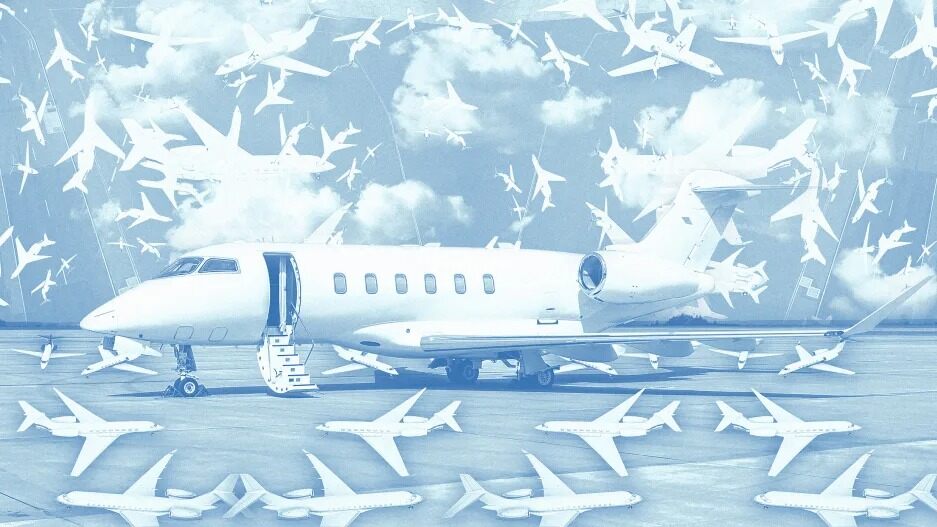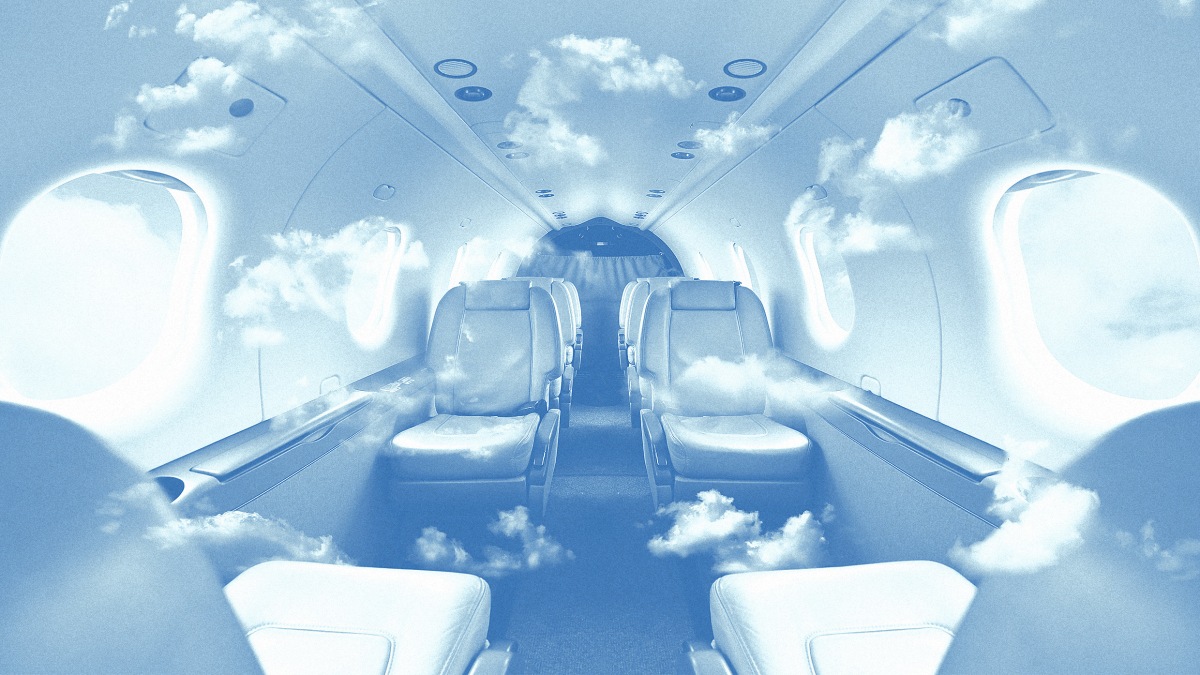- | 9:00 am
More people are flying in private jets, and it’s ruining air travel for the rest of us
Some companies are trying to make private aviation more accessible. But wealthy flyers and critics alike disapprove of any efforts toward ‘democratization.’

If you flew from L.A. to San Francisco with Surf Air, your experience would look a lot different from your run-of-the-mill trip out of LAX. Instead of dealing with that hub’s heaving crowds and security nightmares, you’d show up at Hawthorne Municipal Airport nearby, just 20 minutes in advance of your flight—and avoid all the lines and TSA scrutiny.
In the lounge, you’d have a free cup of coffee as you flipped through The Wall Street Journal. When you boarded the eight-seater plane—after someone carried on your luggage for you—you’d be personally greeted by the pilot, who’d run you through a flight briefing. Soon, after settling into the Swiss-crafted roomy interior, designed in partnership with BMW, you’d be at San Carlos Airport, just south of San Francisco.
That experience stands in sharp contrast with today’s commercial flights: tiny trays and bad food, cramped cabins and tight legroom, frantic boarding and scant overhead space. The miserable experience has led to private aviation growing in recent years, but it’s still an out-of-reach fantasy for most people.
As inequality has increased around the world, one clear marker is private jet travel, the preferred mode of transport for the Mark Zuckerbergs and Taylor Swifts of the world. While some companies say flying private isn’t just for the highest incomes, it still remains out of reach for the vast majority of travelers. And critics say “democratization” of private aviation isn’t a desirable goal anyway, given its immense environmental impact.
The opulence of private jets isn’t just something out of Succession. Approved Jets, a travel agent for charter flights and experiences around the world, caters to “ultra-high-net-worth celebrities” including musicians, hedge funders, attorneys, and athletes, says cofounder Aaron Wilson, adding that a flight from New York to Miami usually runs around $32,000. The company works with a network of 1,000 aircraft, and helps customers add other ritzy features to their schedules, including villas, yachts, and on-board catering, which “can be from something as simple as a fruit platter to lobster, scallops, [and] lamb chops,” says Kelvin Mensah, the other cofounder.
These types of experiences are growing in popularity. Private jet use has increased by 20% since the onset of the pandemic, with approximately 5.3 million flights globally in 2022. Sales of private jets are likely to hit a record this year, at $34.6 billion, and the U.S. has about 63% of the world’s private fleet. With the surge in demand, more services are cropping up to serve the rising consumer base.
Another company taking advantage of this increased demand is Fly Air, an AI-powered app that allows clients to book private flights—“the TripAdvisor of private aviation,” says CEO Stuart Bullard, formerly a music producer for Dr. Dre’s label. Many of his clientele are young entrepreneurs. “In private aviation, you’re going to get that same experience of the Pan American days,” Bullard says. They can range anywhere from $1,800 to $10,000 per hour.

A SYMPTOM OF WEALTH INEQUALITY
The pandemic seemed to accelerate the move from commercial to private, as people wanted to avoid confined spaces with masses of people. But Chuck Collins, senior scholar at the progressive Institute for Policy Studies, says there’s a bigger driver. “The growth in private aviation is more of a reflection of inequality,” says Collins, who has coauthored multiple reports on the detriments of private jets. Just as private jet ownership and usage has increased, there are now 10 times more billionaires than in 1990. One of his reports shows the median wealth of a private jet owner is $190 million.
There is widespread belief that the quality of commercial air travel has declined, and Collins agrees. “[It’s] becoming more overcrowded, more degrading, more physically uncomfortable,” especially for those flying in lower classes. He views air travel as one of the clearest symbols of classism in America, most visibly in the “degraded” nature of having to line up to board in class order. “If you’re at the end, you’re like the lowest form of steerage,” he says. “You’re lucky they don’t flog you as you get on the airplane.”
But wealthier travelers have the luxury of opting out. Many who would have flown in first or business class no longer want to deal with the crowds and security. “First class just isn’t good enough anymore,” Collins says. They don’t want to mix with the many more people now allowed in the Delta Sky Lounge, for instance: “The commoners in there dressed in sweatsuits, with strollers, who want the free soda,” he says.
To try and retain some of these customers, commercial carriers have started offering options closer to private travel, like exclusive lounges, including United’s Polaris and American’s Flagship. “Commercial is reaching skyward, and the private jet industry is reaching down to grab a few more people,” Collins says.
One company claiming to accommodate a wider range of clientele is Surf Air. The company runs a “semi-private” service: While it also offers charter flights, it has an all-you-can-fly membership of $2,500 a month that covers any scheduled services in and out of regional, private airports, like Hawthorne and San Carlos in California.
Flyers can also choose to pay for individual legs, which are usually around $250 to $350. It’s essentially a rideshare, with seven or eight other people, in the same plane you’d pay $5,000 for if you chartered it. “It really is the charter flying experience for the general public,” says CEO Stan Little. Since a merger earlier this year, Little says a priority is to release lower-tier plans and offer discounted seats and multipacks. “My goal as CEO is that this is not an airline for the top one or two or three percent,” he says. “This is an airline for everybody.”
But for the vast majority of people, private aviation costs are still way out of reach, leading Collins to reason that “democratization” simply means it’s now accessible to the top 2% rather than just the 1%. “To me, democratizing private jet travel is a little bit of a joke,” he says.
‘INDEFENSIBLE’ EMISSIONS
As the private jet travel grows, commercial flyers are increasingly bearing the brunt of it. They may experience delays due to congested airspace, and according to Collins’ report, pay a much greater share of airline taxes to fund the FAA; private jet owners pay a comparatively tiny amount to use the shared airspace.
Then, there’s the major criticism of private jets: the massive environmental toll. Private jets emit about 10 times more greenhouse gases per passenger compared to commercial flights; private emissions have increased 23% since 2019. “There is an ecological limit” to how much the industry can grow, Collins says. “At a certain point, aviation is going to hit the hard wall of emissions.”
Especially in Europe, that’s led to protests, including the 200-person demonstration last November at Amsterdam’s Schiphol Airport, Europe’s fourth largest airport. Seventeen thousand private jets passed through Schiphol in 2022, many heading to or from vacation hotspots like Ibiza and Cannes. Shortly after the protests, Schiphol announced it was moving to ban private jets from its hub, despite the potential significant cost to business.
But the plan will undoubtedly face legal challenges as well as strong opposition from powerful airline companies. Separately, the EU’s transport commissioner declined to discuss new private jet measures despite requests from the Netherlands, Austria, and France to reconsider stronger regulations given the “great harm” caused by “excessive per capita carbon footprint.”
In the U.S., lobbying groups like the National Business Aviation Authority, which advocates for private air travel for business purposes, point to so-called solutions like sustainable aviation fuel and carbon offsets. Travelers can sometimes pay for offsets; Fly Air’s Bullard says five passengers on a flight from Art Basel to Puerto Rico’s Blockchain Week last year paid a total of $35 to offset the 5.8 metric tons of emissions toward a reforestation project in Borneo.
GOING ELECTRIC
But these options largely serve as justifications for the practice to continue. The innovation that could have a more significant impact is electrification, which Little says is a priority for Surf Air. The company is partnering with Cessna Caravan, a line of small aircrafts, to launch a fleet of electric vertical take-off and landing (eVTOL) planes, which Little says should start flying in about three years, once they’ve bridged certain regulatory and engineering issues.
Electrification of private jets could be a valuable solution, says Laurie Garrow, an assistant professor at the School of Civil and Environmental Engineering at Georgia Institute of Technology. In some cases, she argues, electrified private jets will have merit, especially for rural hubs that have few connections. There are 5,000 airports in the U.S., and fewer than 10% of them have commercial service. “One of America’s greatest underutilized resources is its small airport infrastructure,” she says. The interest is there: All the major carriers have linked up with cutting-edge private eVTOL companies: United with Archer, Delta with Joby, and American with Vertical.
At first, private eVOTLs will be for high-income individuals, Garrow admits. But with advancements in tech, she says the price will decrease, just as the price of traditional jets did. (A transatlantic flight on Comet Air, the first-ever commercial jetliner, was about $10,000 in the late 1950s, adjusted for inflation.) “If we are able as an industry to get that cost down, that’s where the democratization happens,” she says.
But Collins isn’t swayed by electrification, given it’s a far-off reality for larger jets, where electrification would make a real impact. For him, these arguments simply allow the continuation of this “indefensible form of travel on a warming planet.” What’s more, it’s clear many of the rich want to keep private travel elite. “My clients don’t want to share,” says Approved Jets’ Mensah. “They prefer not to be open too much to the public.”
For Collins, the conversation should instead be about shifting to other green transportation, like high-speed rail. “In the same way we shouldn’t be building new fossil fuel infrastructure,” he says, “we shouldn’t be building new private jet capacity.”
He thinks what might finally push the wealthy to rein in private jets would be mandating a higher jet fuel tax for private flyers, so that they were paying their fair share to use the airspace. And eventually, that could spur the improvement of transport for the masses. “If the private jet high-fliers were required to be on the same transit system as everyone else,” he says, “do you think that the commercial situation will be tolerated in its current form? No.”






































